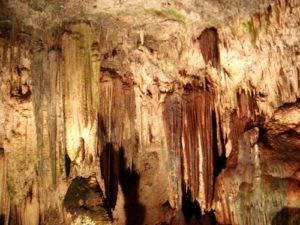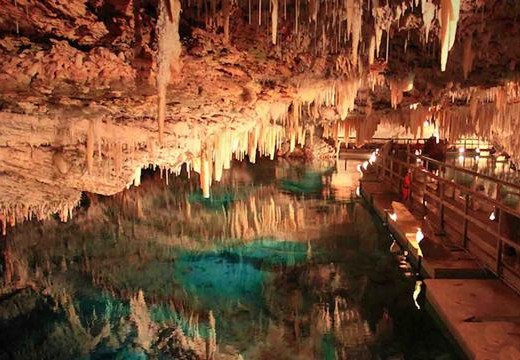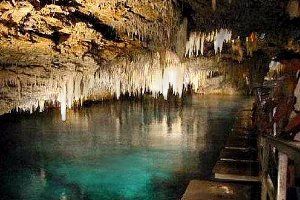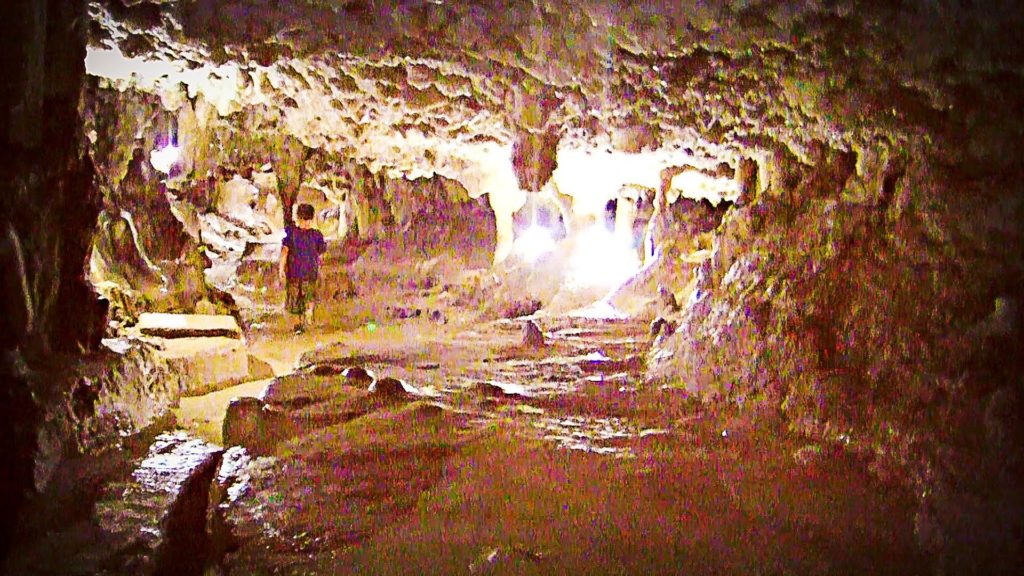 A GIFT OF NATURE: THE CAVES OF BELLAMAR, MATANZAS, CUBA.
A GIFT OF NATURE: THE CAVES OF BELLAMAR, MATANZAS, CUBA.
Bellamar Caves are located on the north coast of Cuba, about five miles from the center of the city of Matanzas. Once inside the beautiful cave the visitor can see the effect of time on the beautiful stalactites, stalagmites and other formations.
The galleries and passages of the caves began to form about 30 million years. Originally the plain in which are the caves were under the sea, was part of the Bay of Matanzas. During the call failure Bellamar groundwater, in combination with carbon dioxide was dissolving the limestone and thus creating underground chambers in the subsoil under the seabed. While these caves remained under sea level were filled with water. Then, tectonic consequences (movements in the earth layers), this area was raised, forming marine terraces that are noted in the land in the city of Matanzas and its surroundings.
Eventually the caverns were drying; draining even cavities that are deep under the sea level. After the leaks began among the rocks on the roof of the caves. The leaks of water with dissolved calcium carbonate were leaving waste where leaking, forming stalactites hanging from the ceiling and stalagmites on the floor. Stalactites are cylindrical at first, as its size increases take the conical shape. Stalagmites are usually conical or flattened, as melted. The stalactites and stalagmites grow well, forming columns when the two come together. In some cases several stalactites are relatively fences, and increase their proportions as they are united, resulting in the formations called formats. Other times are close to the wall, and those are the waterfalls. In Bellamar Caves are all these formations and even more interesting is that despite years old already have in terms of caves are relatively young, which in common language means that even these formations are springing up and the familiar , growing.
Something very interesting Bellamar Caves is that they also have crystal formations of transparent and shiny appearance. These formations do not originate from the same way stalactites and other structures described above. These crystals are caused by water-filled pockets. Even more interesting is that in certain pockets of sedimentary formations caves are covered by a crystalline layer. This indicates that after drying, re-flooding of these cameras completely, or at least partially. These caves have a rare beauty in the world of caves and many of the formations are bright due to the crystalline layer that covers them.
The entrance to the Caves of Bellamar cavity is called Gothic Hall. It’s a camera in a grid pattern and measures 80 meters long and 25 meters wide. In this room you have named some of the formations, among others is the Garden of Carrots, The Chapel of the Twelve Apostles, Doña Mamerta and perhaps the most famous is the Mantle of Columbus. But Bellamar Caves are not only this room, the cavity extends to the east and west achieved a length that exceeds three miles long, and is estimated to be much larger and still cameras completely flooded. There is also at least one other cavity almost parallel to the north. Other cavities are the Hall of Two Lakes, the Hall of the sponges, the Gallery of the Dwarves and the Hall of Megalocnus east of the Gothic Hall. In the other direction are the passage of Hatuey, the Ladies Room, Lake of the Dalias and American Bath (before the English).
Originally it was called La Cueva de Parga, which as we know was the owner of the property where the cave was discovered, the first to explore and the first to show them the world. Indeed, according to scientists is a single cave with several rooms, but as is the custom in the plural, and the present. Shortly after he changed the name to The Caves of Bellamar due to its proximity to the beach Bellamar, west of the city of Matanzas and the coast of the bay, where at that time had begun to build a summer house .
As mentioned, the sections that have been explored with a total length of 3.225 meters (just over three kilometers). There are several galleries running parallel and at various levels. In total they have a length of about twenty miles, which is considerable but not surprising in the underworld, the Mammoth Cave in Kentucky, USA, achieved about 580 kilometers. Sure, it is estimated that in the Caves of Bellamar there is still much more to know and Mammoth Cave is one of the most explored in the world. The one presented here is not the only one crystalline formations. The Jewel Cave in the Black Hills of South Dakota, United States, has much more astonishing crystalline formations, but that does not take away the grace to Bellamar, which in itself is a beauty.
 UN REGALO DE LA NATURALEZA: LAS CUEVAS DE BELLAMAR, MATANZAS, CUBA.
UN REGALO DE LA NATURALEZA: LAS CUEVAS DE BELLAMAR, MATANZAS, CUBA.
Las cuevas de Bellamar están ubicadas en la costa norte de Cuba, a unos 8 km del centro de la ciudad de Matanzas. Una vez dentro de la hermosa cueva, el visitante puede ver el efecto del tiempo en las hermosas estalactitas, estalagmitas y otras formaciones.
Las galerías y los pasajes de las cuevas comenzaron a formarse hace unos 30 millones de años. Originalmente la llanura en la que se encuentran las cuevas bajo el mar, formaba parte de la Bahía de Matanzas. Durante la falla de la llamada, el agua subterránea de Bellamar, en combinación con el dióxido de carbono, disolvió la piedra caliza y creó cámaras subterráneas en el subsuelo bajo el lecho marino. Mientras estas cuevas permanecían bajo el nivel del mar se llenaban de agua. Luego, las consecuencias tectónicas (movimientos en las capas de tierra), esta área se elevó, formando terrazas marinas que se observan en la tierra en la ciudad de Matanzas y sus alrededores.
Eventualmente las cavernas se estaban secando; drenando incluso las cavidades que se encuentran bajo el nivel del mar. Después de las filtraciones comenzaron entre las rocas en el techo de las cuevas. Las filtraciones de agua con carbonato de calcio disuelto dejaban residuos en las filtraciones, formando estalactitas que colgaban del techo y estalagmitas en el piso. Las estalactitas son cilíndricas al principio, ya que su tamaño aumenta tomando la forma cónica. Las estalagmitas suelen ser cónicas o aplastadas, como derretidas. Las estalactitas y estalagmitas crecen bien, formando columnas cuando las dos se unen. En algunos casos, varias estalactitas son relativamente vallas, y aumentan sus proporciones cuando están unidas, dando como resultado las formaciones llamadas formatos. Otras veces están cerca de la pared, y esas son las cascadas. En las Cuevas de Bellamar se encuentran todas estas formaciones y aún más interesante es que a pesar de los años que ya tenemos en cuanto a cuevas son relativamente jóvenes, lo que en lenguaje común significa que incluso estas formaciones brotan y las familiares crecen.
Algo muy interesante de las Cuevas de Bellamar es que también tienen formaciones de cristales de apariencia transparente y brillante. Estas formaciones no se originan del mismo modo que las estalactitas y otras estructuras descritas anteriormente. Estos cristales son causados por bolsillos llenos de agua. Aún más interesante es que en ciertas bolsas de formaciones sedimentarias las cuevas están cubiertas por una capa cristalina. Esto indica que después de secarse, vuelva a inundar estas cámaras por completo, o al menos parcialmente. Estas cuevas tienen una rara belleza en el mundo de las cuevas y muchas de las formaciones son brillantes debido a la capa cristalina que las cubre.
La entrada a la cavidad de las Cuevas de Bellamar se llama Salón Gótico. Es una cámara en un patrón de cuadrícula y mide 80 metros de largo y 25 metros de ancho. En esta sala has nombrado algunas de las formaciones, entre otras, el Jardín de las Zanahorias, La Capilla de los Doce Apóstoles, Doña Mamerta y tal vez el más famoso es el Manto de Colón. Pero las Cuevas de Bellamar no son solo esta habitación, la cavidad se extiende hacia el este y el oeste alcanzan una longitud que excede las tres millas de largo, y se estima que es mucho más grande y las cámaras todavía están completamente inundadas. También hay al menos otra cavidad casi paralela al norte. Otras cavidades son el Salón de los Dos Lagos, el Salón de las Esponjas, la Galería de los Enanos y el Salón de Megalocnus al este del Salón Gótico. En la otra dirección están el paso de Hatuey, el Ladies Room, el Lake of the Dalias y el American Bath (antes de los ingleses).
Originalmente se llamaba La Cueva de Parga, que como sabemos era el dueño de la propiedad donde se descubrió la cueva, la primera en explorar y la primera en mostrarles el mundo. De hecho, según los científicos es una cueva única con varias habitaciones, pero como es la costumbre en el plural, y el presente. Poco después cambió el nombre a Las Cuevas de Bellamar debido a su proximidad a la playa de Bellamar, al oeste de la ciudad de Matanzas y la costa de la bahía, donde en ese momento había comenzado a construir una casa de verano.
Como se mencionó, las secciones que se han explorado con una longitud total de 3,225 metros (poco más de tres kilómetros). Hay varias galerías en paralelo y en varios niveles. En total, tienen una longitud de unas veinte millas, lo cual es considerable pero no sorprendente en el inframundo, la Cueva Mammoth en Kentucky, EE. UU., Logró unos 580 kilómetros. Claro, se estima que en las Cuevas de Bellamar todavía hay mucho más por conocer y Mammoth Cave es una de las más exploradas en el mundo. El que se presenta aquí no es la única formaciones cristalinas. La Jewel Cave en Black Hills de Dakota del Sur, Estados Unidos, tiene formaciones cristalinas mucho más asombrantes, pero eso no le quita la gracia a Bellamar, que en sí misma es una belleza.
Agencies/Wiki/ Internet Photos/ Arnoldo Varona/ TheCubanHistory.com
THE CUBAN HISTORY, HOLLYWOOD.










